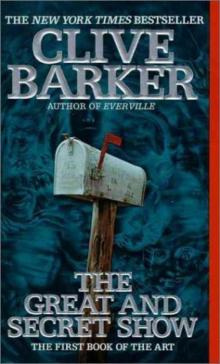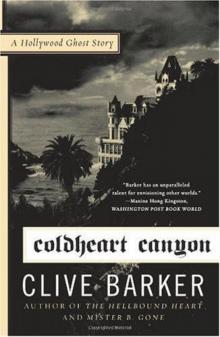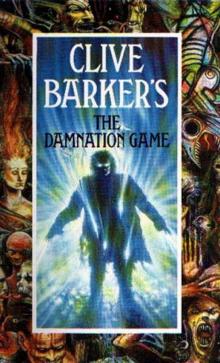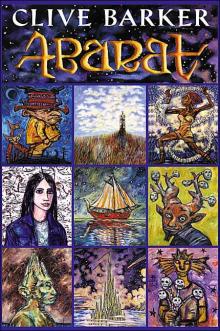- Home
- Clive Barker
The Essential Clive Barker
The Essential Clive Barker Read online
THE ESSENTIAL
CLIVE BARKER
SELECTED FICTION
WITH FOREWORD BY
ARMISTEAD MAUPIN
For Jane Johnson
I am a man, and men are animals who tell stories. This is a gift from God, who spoke our species into being, but left the end of our story untold. That mystery is troubling to us. How could it be otherwise? Without the final part, we think, how are we to make sense of all that went before; which is to say, our lives?
So we make stories of our own, in fevered and envious imitation of our Maker, hoping that we’ll tell, by chance, what God left untold. And finishing our tale, come to understand why we were born.
—from Sacrament
CONTENTS
FOREWORD BY ARMISTEAD MAUPIN
PRIVATE LEGENDS:
AN INTRODUCTION
ONE DOORWAYS
TWO JOURNEYS
THREE VISIONS AND DREAMS
FOUR LIVES
FIVE OLD HUMANITY
SIX BESTIARY
SEVEN LOVE
EIGHT TERRORS
NINE THE BODY
TEN WORLDS
ELEVEN MAKING AND UNMAKING
TWELVE MEMORY
THIRTEEN ART
APPENDIX
PERMISSIONS
ACKNOWLEDGMENTS
ALSO BY CLIVE BARKER
ABOUT THE AUTHOR
COPYRIGHT
ABOUT THE PUBLISHER
FOREWORD
ARMISTEAD MAUPIN
A quick confession: I discovered Clive Barker’s work through a comic book, a graphic rendition of his brilliant story “In the Hills, the Cities” that had the good sense to leave much of his language intact. The story was nothing less than a waking nightmare—perfectly suited for illustration — but what lingered with me was the absolute authority of Barker’s voice. He wrote with the easy confidence of a tribal storyteller, an elder who had seen everything and committed most of it to scripture. And every novel of his I’ve read since has been embued with the same quality, the same stately Biblical certitude. Somehow, through an alchemy other writers can only envy, even Barker’s most bizarre tales have the ring of history to them, a core of ancient truth that allows us — no, compels us — to follow him anywhere.
And anywhere, for him, means everywhere. Nothing is off limits to this free-range fabulist. He can fold a dusty Persian carpet into the contours of the world itself and wring delight from every lustrous thread. He can build a battling giant out of thousands of contorted human bodies and enlist our aid in its construction. He can make us believe we’re fondling the genitals of an alien — and thoroughly enjoying it to boot. And though he’s also mastered the visual arts on both canvas and celluloid, he accomplishes these wonders with words alone, manipulating our dreads and desires until we believe the unbelievable, think the unthinkable. Or, as one of his characters puts it so well in Imajica, until we “stop looking and see.”
This happens, in part, because we are led into these incredible realms by such credible guides. Barker’s people are as real as anyone in Updike or Welty, flawed and idiosyncratic, anything but the stick figures that too often inhabit the work of best-selling fantasists. And most of his characters live in low-tech landscapes we can readily recognize. They endure the hardships of inner-city housing projects, or cruise the bars in San Francisco’s Castro District, or rage against the tedium of a heartland post office. They are prigs and libertines, monsters and angels, the casually evil and the profoundly ordinary. They long for love and strive for fulfillment and seek meaning from the random struggles of existence. Barker will never be confined to a “genre”—that most condescending of literary labels—having grasped something basic about his art: when the horrific and the humane coexist believably in a work of fiction, the reader’s experience of each is heightened.
Then there’s the sex. Barker writes about human desire in the most visceral—and fearless — way imaginable, stimulating all our senses at once. And while he’s one of the few globally popular artists to be off-handedly frank about his homosexuality, his celebration of the body and its pleasures is thoroughly ecumenical. I can think of no other writer who writes so generously about everyone’s passion, whether hetero-, homo- or omni-, rough sex or gentle; all are acceptable in Barker’s dominion. And why not? he seems to be saying. In a world so chock-a-block with shape-shifters and mystifs, creatures who can morph into anything at the blink of an eye, why deny us lowly mortals a few interesting options of our own?
As a writer, I’m always intrigued by Barker’s reverence for the power of myth-making, a theme that pervades much of his work. He sees storytelling as a tool for spiritual growth, a means of making sense of things, not just for the reader but for the writer himself. Listen to his narrator in Galilee:
Now I had the answer to the question: what lay at the center of all the threads of my story? It was myself. It wasn’t an abstracted recaunter of these lives and loves. I was—I am—the story itself; its source, its voice, its music. Perhaps to you that doesn’t seem like much of a revelation. But for me, it changes everything. It makes me see, with brutal clarity, the person I once was. It makes me understand for the first time who I am now. And it makes me shake with anticipation of what I must become…. In other words, there must inevitably be unholy business here, just as there will be sacred, but I cannot guarantee to tell you—or even sometimes to know—which is which…. All I want now is the time to enchant you …
And who could decline such an offer? The symphonic grace of Barker’s prose, his loping, muscular imagination, his sharp eye on the human dilemma — all serve a seamless, remarkable whole. Add to that his uncanny gift for scaring the daylights out of you and there’s more than enough reason to be grateful he’s on the planet.
Assuming, of course, he is.
PRIVATE LEGENDS
AN INTRODUCTION
private 1 archaic: one not in public life or office 2: a secret message 3: privates p1. genitalia.
legend 1: the story of the life of a saint 2: a story coming down from the past 3: an explanatory list of the symbols appearing on a map or chart.
I
There are three stories at the heart of this introduction. One concerns a Bird Man, one a Magician, and one, the Sea. They are all true; accounts of events that happened in my life which I’ve attempted to tell as plainly as possible. On the face of it their presence here might seem a little odd. This is, after all, the introduction to a book of imaginings; selections from volumes that take reality as a starting point for journeys into other states of soul and bone. But these journeys, however remote their destinations, are always rooted in some personal experience. Their truth is the truth of things seen, things felt. I wanted that fact to be somehow reflected in these pages; to mingle some observations on the kind of work I make — and the means by which I make it—with examples of events which have moved and marked me.
This exchange between the world and the work is a two-way street. I hope to make stories powerful enough to reflect back upon reality, and perhaps, in some subtle way, transform it. I want to charge up the minds of my readers with a taste of otherness, and deliver them back into the world ready to make a new sense of it. Arguably, all art intends this. But the fantastique, as I will dub the fruit of the imagination, performs this duty in a fashion quite unlike that of novels or films or paintings that are created to be mirrors of life. The fantastique is not content, let’s say, to show us a horse. Or a man standing beside a horse. Instead it says: let’s marry the horse and the man, to see what comes of it. The resulting creature, a centaur, is of course familiar to us from classical mythology; though in fact a primal confluence of beast and man appears in the earliest known
examples of art, cave paintings. It’s a game, this marrying of disparate pieces, which seems fundamental to us. Children play it with instinctive ease. Left to their own devices they will match and marry forms without a thought to propriety. They let the world melt in their own minds, and pluck whatever pleases them out of the resulting stew. Many of these liaisons are often simply a diverting nonsense; which is a perfectly acceptable end in itself. But sometimes, as for instance in the case of the centaur, these forms carry a potency all their own. When we look at the man who is also a horse a plethora of fascinating questions arise. We may be inspired to think in a new way about our sexuality, or our bestiality, or our history as a species that has tamed and domesticated other species. We may find ourselves strangely aroused by the image: by its nakedness, its power, its enviable lack of inhibitions. The image of the horse-man has become a vessel for a cluster of thoughts that might otherwise slip away, lost in the crush and din of the solid world.
The history of the fantastique presents us with an extraordinary array of such vessels, including, but by no means limited to: stories of the womb; stories of the state or states which precede the womb; ruminations on the origin of the soul; ruminations on the destination of the soul; nonsense rhymes, nursery tales; lullabies and prayers; heroic tales of a Golden Age; fairy tales of a Magic Age; tales of lost time, tales of lost sanity; tales of lost love, returned from the grave; tales of any manner of creature returned from the grave; histories of supernatural species or tribes of supernatural species including angels, demons, vampires, werewolves; accounts of the efficacy of occult forces; accounts of pacts made with Infernal Powers, and their consequences; all unholiness; all holiness; all tales of spiritual endeavor; topographies of invented islands; descriptions of invented voyages; scenes set in floating cities and lost continents; books set in Heaven; books set in Hell; books set in the mind of God, especially those which purport to explain the will of God; anything with scenes of talking animals, anything with scenes of articulate stones, or wells or roses; grimoires, operas, drag shows; stories of removal to other worlds or dimensions by means which do not yet exist; stories set in those worlds or dimensions; stories in which paranoid delusions are substantiated; hallucinations and deliriums, opiated dreamscapes; reports of the monstrous, the grotesque, and the freakish; uncollected gospels; visions of the end of the world; visions of what will come after the end of the world; erotic fantasias upon the rituals of love; stories in which one or other lover is miraculously transformed (into a cloud, a bull, a rain of gold); stories in which the object of desire survives impossible vicissitudes in order to entertain the author; stories in which the genitalia speak; stories of obscene excess; stories of eternal love; stories of eternal virgins; stories of the impregnation of such virgins by the Holy Spirit; and so, as in some inevitable circle, back to stories of the womb.
II
There have been countless, mostly misbegotten, attempts to divide the various modes of the fantastique: the sorry consequences of these divisions are visible at your local bookstore. You’ll find one species of imagining dubbed science fiction, another shelved under horror; yet another under fantasy. Some—magic realism, for instance—are simply collected on the literature shelves. Away with that nonsense, here and now. A lot of good reading time can be wasted arguing whether Nathaniel Hawthorne belongs with Italo Calvino, or Kurt Vonnegut with the Brothers Grimm.
One particularly fruitless definition of the fantastic, offered by literary critic Tzvetan Todorov, cites it at a place in a story in which two possibilities (one defying the laws of reality, the other caused by a dislocation of the senses) exist side by side. The moment the narrative chooses one road or the other, Todorov argues, the fantastic mode passes away. In my experience these attempts to organize and compartmentalize the labors of the imagination are strictly for the entertainment of theorists. Let me give you a case in point.
Sitting in various stacks around my desk as I write are the four books I presently have in progress. One is this, The Essential Clive Barker, another is an untitled collection of short fiction, the third a book of erotic prose and paintings, called The Scarlet Gospels, and the fourth a book I’ve been working on for three years called The Book of Hours. None of them is remotely like another. There is work here which will be published as children’s fiction, and work which plays into the heart of my sexual obsessions; there’s a story in the collection set in a future which I hope is wholly unlike any created, and another set in a canyon inspired by the landscape outside the window. Some days, when an idea strikes me, I will hop from one text to another; and every day, without fail, I will put my pen down at the end of the afternoon and go to paint the pictures for The Book of Hours in my studio next door, never feeling as though I have to actively remove myself from one world and beg entrance to another. Why? Because my mind is not divided like a bookshop. It doesn’t have a compartment into which my erotic feelings are put, and another where my prophetic aspirations go, and another where I put my hunger to make an archipelago for children: it’s all one place. Of course I’m not going to write in the erotic mode for an audience of children, nor drop a scene about enchanted hats into a story about Hell, but that doesn’t mean there isn’t a connection between these subjects. Where, for instance, is the bridge that leads from the dream-sea Quiddity, and the islands of the Ephemeris that are set in that sea, to the five Dominions of the Imajica? Or from the Weaveworld, with its Fugue and Gyre, to Hood’s Holiday House? From the ruins of Warsaw in 1944 to the Rub al Khali, the Empty Quarter of the Sahara?
To help answer those questions, I’ve put excerpts of the stories side by side, so that the connections become more apparent. To take an example: in chapter 11, Making and Unmaking, there are pieces of wild fantasy (a chapter titled “The Miracle of the Loom,” from Weaveworld, and a portion of the climax of The Thief of Always) alongside a key passage from Galilee in which the narrator, Maddox Barbarossa, ruminates on the scale of his ambition for the story he is about to tell. And then, from Sacrament, two much darker passages, which concern themselves with a boy coming to understand his power in the world. It matters not at all how these various books might be described generically: the thematic material is more important than the way a bookseller may decide (or be obliged) to position the book. What does the terminology matter? The urgency of the story is what drove me to write these passages in the first place. The rest is just packaging. It’s irrelevant the moment a reader invests his or her time and imagination in the work.
Of course there’s an exploratory element to such organization. Arguably some of the selections might well belong in more than one chapter. There’s nothing definitive in any of this. But that may be part of the essence of such pathfinding. As Gentle, the protagonist in Imajica, muses toward the end of that novel: “maps weren’t cursed by the notion of a definitive original … [they] were always works in progress.”
III
So, it’s a work in progress. And I don’t expect anybody to pick this book up, begin on page one, and dutifully read on to the end. Very few people, I think, will do that. I put up my signposts, in the full knowledge that they will largely go ignored. I think one of the pleasures of a collection like this is that it encourages a nomadic spirit. You wander here and there, guided only by some vague instinct.
I feel the same way as a writer. I do my best to lay out the trip I want to take when I begin to write a book, but I seldom stay very close to it. The fantastique lends itself to digression; it feeds upon its own spiraling inventions. The first appearances of such storytelling—in folklore and myth and in fairy tale (later, in urban legend)—are celebrations of their own fecundity. Heaven and Hell are populated by such stories, seas and species and stars spun into being. Here let me be quite clear: the primary impulse behind such creations is not escapism. That implies a kind of cowardice in the face of the world, which is not what inspires such visions. Quite the reverse. It is a hunger to see more clearly that fuels the true fantasist. A desire to expre
ss the world’s transforming heart.
Sometimes, of course, events uncover their mythic selves without any help from a writer. Such events often become part of our personal landscape; pivotal moments around which our lives seem to organize themselves.
My first confrontation, in the flesh, with an image that had this kind of mythic resonance occurred when I was very young. In May 1956, as a four year old, I was taken to an air show at Speke Airport, on the outskirts of Liverpool. It was a big event. The city was still getting out of its postwar doldrums, and entertainment was hard to come by. I have a very clear memory of what happened that day, a memory sharpened by the process of describing it in the drafts of this piece, and by several conversations with my father, who also plays a significant part in these events. I remember the heat of an intemperate English August, and a tiny car filled with people: my parents; my aunt and uncle; my cousin, still a babe in arms; and myself. The air was stagnant, the sky blindingly bright. The family, lacking the wherewithal to get everyone inside the airfield so as to watch the fly-bys from the tarmac like the paving crowd, stood near the car, parked at the edge of a cornfield close to the perimeter fence. I was bored, I think; the periods of waiting between the passing of the planes seemed interminable. My shirt stuck to the back of my neck; there were late summer wasps buzzing around, coming after our sandwiches.
The high point of the afternoon’s entertainment was to be a flight by a much-celebrated Bird Man. His name was Leo Valentin, and his performance, which had been seen throughout Europe (the man was French) was this: he jumped from a circling plane and glided on homemade balsa wood wings until he reached a certain altitude, at which point he pulled his rip cord and parachuted to earth.

 The Great and Secret Show
The Great and Secret Show Coldheart Canyon: A Hollywood Ghost Story
Coldheart Canyon: A Hollywood Ghost Story Galilee
Galilee Cabal
Cabal The Adventures of Mr. Maximillian Bacchus and His Travelling Circus
The Adventures of Mr. Maximillian Bacchus and His Travelling Circus Everville
Everville Books of Blood: Volume Three
Books of Blood: Volume Three Weaveworld
Weaveworld The Scarlet Gospels
The Scarlet Gospels Sacrament
Sacrament Books of Blood: Volumes 1-6
Books of Blood: Volumes 1-6 Sherlock Holmes and the Servants of Hell
Sherlock Holmes and the Servants of Hell Mister B. Gone
Mister B. Gone Imajica
Imajica The Reconciliation
The Reconciliation Abarat
Abarat Clive Barker's First Tales
Clive Barker's First Tales The Hellbound Heart
The Hellbound Heart The Inhuman Condition
The Inhuman Condition Infernal Parade
Infernal Parade Days of Magic, Nights of War
Days of Magic, Nights of War The Thief of Always
The Thief of Always Books of Blood Vol 2
Books of Blood Vol 2 The Essential Clive Barker
The Essential Clive Barker Abarat: Absolute Midnight a-3
Abarat: Absolute Midnight a-3 The Damnation Game
The Damnation Game Tortured Souls: The Legend of Primordium
Tortured Souls: The Legend of Primordium Books of Blood Vol 5
Books of Blood Vol 5 Imajica 02 - The Reconciliator
Imajica 02 - The Reconciliator Books Of Blood Vol 6
Books Of Blood Vol 6 Imajica 01 - The Fifth Dominion
Imajica 01 - The Fifth Dominion Abarat: Absolute Midnight
Abarat: Absolute Midnight The Adventures of Mr. Maximillian Bacchus & His Traveling Circus
The Adventures of Mr. Maximillian Bacchus & His Traveling Circus Tonight, Again
Tonight, Again Abarat: The First Book of Hours a-1
Abarat: The First Book of Hours a-1 Books Of Blood Vol 1
Books Of Blood Vol 1 Age of Desire
Age of Desire Imajica: Annotated Edition
Imajica: Annotated Edition Complete Books of Blood
Complete Books of Blood Gutted: Beautiful Horror Stories
Gutted: Beautiful Horror Stories Shivers 7
Shivers 7 Books Of Blood Vol 4
Books Of Blood Vol 4